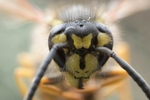Wasps & Hornets
For people who have severe allergic reactions to wasp stings, a wasp nest within a garden or home can be an unnecessary health risk.
• It is the queen wasps that survive the Winter and using wooden fibres chewed from garden fencing or sheds they digest this down to make paper nests.
• A wasp will build a nest in garden sheds or under the eaves of our houses, or if they can gain access, in attics and loft spaces.
• A nest can hold up to one thousand wasps and will be firstly producing workers and then, towards the end of the summer, the next seasons queens and drones to continue the following year.
• There can be between 2,000 & 3,000 queens produced in just one nest at the end of the year to over winter for the following year, however, only about 25% of these will survive the Winter in harsh years.
• Wasps are most active between the months of May and September but depending on weather can be later, as they need a large amount of insects to feed their young.
• Wasps use their venomous sting to defend themselves and their nests as well as it being used to subdue their prey.
• Wasps are generally acknowledged for disrupting Summer picnics, but they are important to our eco system as natural pest controllers for keeping our insect population down and as accidental pollinators, so it is unfortunate that they choose to use suburban areas to populate where some people are allergic to their stings, which could prove fatal.
• Hornets can bite and sting at the same time.
• It is the queen wasps that survive the Winter and using wooden fibres chewed from garden fencing or sheds they digest this down to make paper nests.
• A wasp will build a nest in garden sheds or under the eaves of our houses, or if they can gain access, in attics and loft spaces.
• A nest can hold up to one thousand wasps and will be firstly producing workers and then, towards the end of the summer, the next seasons queens and drones to continue the following year.
• There can be between 2,000 & 3,000 queens produced in just one nest at the end of the year to over winter for the following year, however, only about 25% of these will survive the Winter in harsh years.
• Wasps are most active between the months of May and September but depending on weather can be later, as they need a large amount of insects to feed their young.
• Wasps use their venomous sting to defend themselves and their nests as well as it being used to subdue their prey.
• Wasps are generally acknowledged for disrupting Summer picnics, but they are important to our eco system as natural pest controllers for keeping our insect population down and as accidental pollinators, so it is unfortunate that they choose to use suburban areas to populate where some people are allergic to their stings, which could prove fatal.
• Hornets can bite and sting at the same time.
Return to: Rats
Return to: Rats



